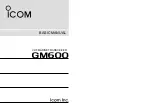
Installation Menu
73
Weak signal or no signal
However, the input frequency range for the receiver is in the range
950 to 2150 MHz. The high frequencies are therefore converted into a
lower frequency using the oscillator frequency (LO frequency/
L.O. = LNB local oscillator). Different oscillator frequencies are used
for the conversion depending on the satellite frequency range and the
system type.
For ASTRA and EUTELSAT reception systems, this is normally
9.75 GHz (9750 MHz) for the lower frequency range (low band) and
10.6 GHz (10600 MHz) for the upper frequency range (high band).
Older reception systems still use a 10 GHz oscillator frequency in the
low band range (which is not normally suitable for digital reception).
The receiver generates the frequency to which it needs to adjust by
subtracting the oscillator frequency from the satellite transmission
frequency saved for each programme. You only have to set the
oscillator frequency used by your reception system. Before chancing
the LO frequency, you must therefore ascertain whether this is
actually necessary.
The oscillator frequencies listed above are the factory settings.
Changing the Oscillator Frequency
Press
to move to the right-hand section of the LNB configuration
menu. The setting for L.O. High is highlighted in colour. You can now
use the number buttons to enter a new frequency appropriate for your
system. Use the
buttons to select L.O. Low and do the same.
Press
four times to exit the menu. This saves the set value.
If you make an incorrect setting, you will see the following message:
Operation
The factory setting is “On”.
Under normal circumstances, the supply voltage should be turned on.
Receiving Two Satellites
If your receiver is connected to a multi-feed antenna, which is aligned
with the HotBird satellites for example, you must change the receiver
settings for the DiSEqC™ signal. This also applies to other satellites
as well of course (DiSEqC™ = Digital Satellite Equipment Control).
Different control signals are required to select the satellite signals. To
date, the LNB supply voltage of 14/18 V and the 22 kHz signal
(superimposed on the LNB supply voltage) have been sufficient for
signal selection for most applications. These four switching signals
allow you to switch between the horizontally and vertically polarised
signals and between two satellites (multi-feed reception).
To extend the frequency range to the 12 GHz range (high band) or for
reception from more than two satellites, additional control signals are
required for LNB actuation and signal selection.
The DiSEqC™ signal is responsible for this. This is a special
modulation of the existing 22 kHz signal.
Содержание UFD 580
Страница 1: ...Operating Manual Twin DVR Sat Receiver UFD 580 580S with Hard Disk Drive ...
Страница 6: ...Safety Instructions Important Information 6 Safety Instructions Important Information ...
Страница 97: ...Service 97 ...
Страница 98: ...Service 98 ...
Страница 99: ...Service 99 ...
















































